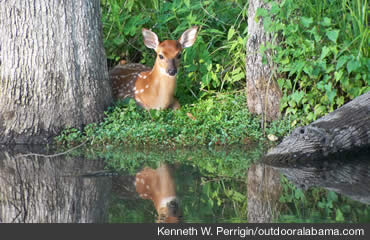It’s spring, you’re taking a walk in the woods, and wait . . . look over there. It’s almost hidden; it’s a baby animal. And it’s all alone. Or is it? What you won’t see is the adult hiding nearby, watching you and waiting for you to leave.
The best thing you can do when you see any young animal is to leave it alone, exactly where and as you found it.
Most wild animals are raised by only one adult and the youngsters are not tended to during daylight hours. Many adult wild animals leave young offspring alone while they forage for food or to divert the attention of potential predators away from vulnerable young.
In the case of white-tailed deer, a doe hides her young from predators by leaving it alone in a secluded spot, such as a grassy meadow or a flower bed. A hidden fawn has virtually no scent, and when left alone it is difficult for predators to find. The doe will tend to the fawn or fawns several times each night.
Even if you have good intentions, rescuing an animal can sometimes cause more harm than good. This is often the case when people come in contact with seemingly orphaned young wildlife.
"Young wildlife taken into captivity can lose their natural instincts and ability to survive in the wild,” explains John Bowers, Georgia’s Wildlife Resources Division chief of game management. “In most instances, there is an adult animal a short distance away. This separation of adult and young animals provides a critical survival mechanism by helping minimize predation on young wildlife.”
Situations become much more complex, and sometimes pose a danger to the wildlife or people, when an animal is moved or taken into a home.
What if the animal is injured? Persons not licensed and trained in wildlife rehabilitation should not attempt to care for wildlife. In many states, laws prohibit the possession of most wildlife without a permit.
If you encounter a seriously injured animal or an animal that clearly has been orphaned, please contact a local licensed wildlife rehabilitator.
 Wildlife doesn’t belong in your home. Handling any wildlife or bringing them into the home poses health risks for both people and domestic pets. Despite the fact that they may look healthy, wildlife can transmit life-threatening diseases such as rabies, and can carry unhealthy and dangerous parasites such as roundworms, lice, fleas and ticks. Ticks are especially known to transmit diseases.
Wildlife doesn’t belong in your home. Handling any wildlife or bringing them into the home poses health risks for both people and domestic pets. Despite the fact that they may look healthy, wildlife can transmit life-threatening diseases such as rabies, and can carry unhealthy and dangerous parasites such as roundworms, lice, fleas and ticks. Ticks are especially known to transmit diseases.
Contact the local county health department and/or state wildlife resources office if you encounter an animal such as a bat, fox, skunk, raccoon, coyote or bobcat that appears to show no fear of humans or dogs, or seems to behave in a sick or abnormal manner (weaving or drooling, for example). The animal may be afflicted with rabies, distemper or another disease.
Do not attempt to feed or handle animals. Pets, livestock and humans should be kept away from the area where the animal was observed.
What about birds?
It is important to leave animals in the wild, and if you accidentally disturb a nest, replace the young animals and the nest material as close to the original location as possible.
It is a myth that wildlife parents will not tend to young because of human scent.
To further protect young and vulnerable wild animals, keep your pets under control so they do not raid nests and injure wild animals.
The two most important to take to protect yourself and your pets from rabies is 1) have your pet vaccinated, and 2) avoid physical contact with wildlife.
Contributors: Georgia Department of Natural Resources Wildlife Resources Division, Ohio Department of Natural Resources, Alabama Department of Conservation and Natural Resources
Photos courtesy of Rodney Brackett/outdooralabama.com and Kenneth W. Perrigin/outdooralabama.com